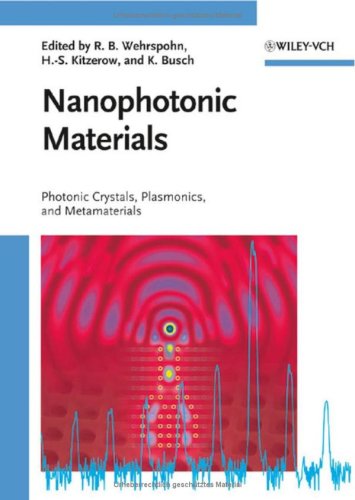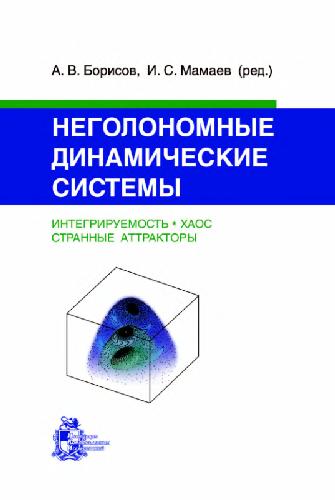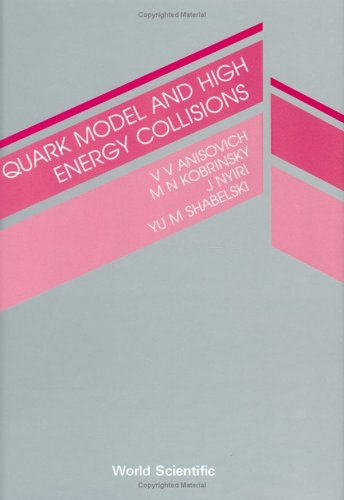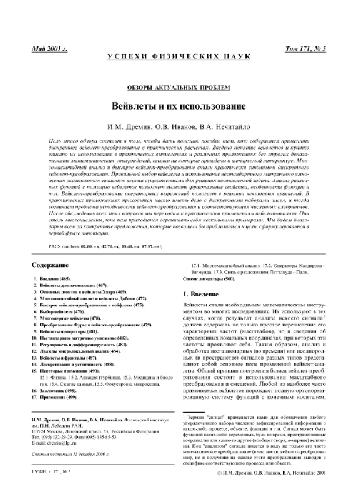Ralf B. Wehrspohn, Heinz-Siegfried Kitzerow, Kurt Busch3527408584, 9783527408580, 9783527621897
Research started with linear, non-dispersive properties of purely dielectric 2D and 3D photonic crystals and progressed to non-linear and dispersive properties of dielectric photonic crystals including gain and / or losses. These properties where studied on different materials systems such as silicon, III-V-compound semiconductors, oxides and polymers, as well as hybrid systems consisting of dielectric photonic crystals and liquid crystals. Applications of these systems were developed in the area of active photonic crystal fibres, functional optical components, and sensors. Some of these have by now even entered into industrial applications.
Table of contents :
Nanophotonic Materials……Page 4
Contents……Page 8
Preface……Page 18
List of Contributors……Page 20
I Linear and Non-linear Properties of Photonic Crystals……Page 32
1.1 Introduction……Page 34
1.2 Variational Approach to the NLCME……Page 36
1.3 Radiation Losses……Page 40
1.4 Results……Page 42
1.5 Conclusions and Outlook……Page 43
References……Page 44
2.1 Introduction……Page 46
2.2 Theoretical Approach……Page 47
2.2.1 Spatially-Inhomogeneous Maxwell Equations in Semiconductor Photonic-Crystal Structures……Page 48
2.2.1.2 Longitudinal Part: The Generalized Coulomb Interaction……Page 49
2.2.2 Hamiltonian Describing the Material Dynamics……Page 50
2.2.3 Semiconductor Bloch Equations in Real Space……Page 52
2.2.3.1 Low-Intensity Limit……Page 53
2.3.1 Semiconductor Photonic-Crystal Structure……Page 55
2.3.2 Linear Excitonic Absorption……Page 57
2.3.3 Coherent Wave Packet Dynamics……Page 60
2.3.4 Wave Packet Dynamics with Dephasing and Relaxation……Page 62
2.3.5 Quasi-Equilibrium Absorption and Gain Spectra……Page 64
2.4 Summary……Page 66
References……Page 67
3.1 Introduction……Page 70
3.2 Opals as Coloring Agents……Page 74
3.2.2 Opaline Effect Pigments by Spray Induced Self-Assembly……Page 75
3.3 Loading of Opals with Highly Fluorescent Dyes……Page 77
3.4.1 Increase of Refractive Index……Page 78
3.4.2 Robust Replica……Page 79
3.4.3 Inert Replica for Chemistry and Catalysis at High Temperatures……Page 80
3.5 Defect Incorporation into Opals……Page 81
3.5.1 Patterning of the Opal Itself……Page 82
3.5.2 Patterning of an Infiltrated Material……Page 84
3.5.3 Chemistry in Defect Layers……Page 86
References……Page 89
4.1 Introduction……Page 94
4.2 Experiment……Page 95
4.3 Coherent Cavity Field Coupling in One-Dimensional CROWs……Page 96
4.4 Mode Structure in Finite CROWs……Page 98
4.5 Slowing Down Light in CROWs……Page 101
4.6 Disorder and Detuning in CROWs……Page 103
References……Page 105
5.1 Introduction……Page 108
5.2.1 Dispersion Tuning……Page 110
5.2.2 Coupled Mode Model……Page 113
5.3 Transmission Efficiency……Page 116
5.4 Aperiodic Nanopillar Waveguides……Page 119
5.5.1 Directional Coupler……Page 120
5.5.2 Laser Resonators……Page 121
5.6 Conclusion……Page 125
References……Page 126
6.1 Introduction……Page 128
6.2 High-Refractive Index Inorganic–Organic Hybrid Polymers……Page 129
6.3.1 Experimental Setup……Page 135
6.3.2 Fabrication of PhC in Standard ORMOCER(®)……Page 136
6.3.3 2PP of High Refractive Index Materials……Page 138
6.3.4 Patterning and PhC Fabrication in Positive Resist Material S1813……Page 142
6.4 Summary and Outlook……Page 143
References……Page 144
7.1 Introduction……Page 146
7.2.1.1 General Remarks……Page 147
7.2.1.2 Preparation Details……Page 148
7.2.2 Characterization and Structure Determination of MSFs……Page 149
7.2.3 Optical Properties of MSFs……Page 152
7.2.4 Synthesis Mechanism……Page 154
7.3.1 Polymer Waveguides……Page 155
7.3.2 Ta(2)O(5) Waveguides and 2D PhC Structures……Page 157
7.3.3 PZT Films……Page 158
7.4 Conclusions……Page 160
References……Page 161
8.1 Introduction……Page 162
8.2 Fabrication of Photonic Crystal Slabs……Page 163
8.3 Linear Properties of Photonic Crystal Slabs……Page 164
8.3.1 Transmission and High Dispersion of Line-Defect Waveguides……Page 165
8.3.2 High-Quality Factor Microcavities in a Low-Index Photonic Crystal Membrane……Page 169
8.3.3 Unusual Diffraction and Refraction Phenomena in Photonic Crystal Slabs……Page 172
8.3.3.1 Self-Collimated Light at Infrared and Visible Wavelengths……Page 173
8.3.3.2 Negative Refraction of Light……Page 174
8.4.1 An Optical Parametric Oscillator in a Photonic Crystal Microcavity……Page 176
8.4.2 Discrete Solitons in Coupled Defects in Photonic Crystals……Page 178
References……Page 183
9.1 Introduction……Page 188
9.2.1 Macroporous Silicon Growth Model……Page 189
9.2.3 Fabrication of Trenches and More Complex Geometries……Page 193
9.3 Defects in 2D Macroporous Silicon Photonic Crystals……Page 195
9.3.1 Waveguides……Page 196
9.3.2 Beaming……Page 197
9.3.3 Microcavities……Page 199
9.4.1 Internal Emitter in Bulk 2D Silicon Photonic Crystals……Page 201
9.4.2 Internal Emitter in Microcavities of 2D Silicon Photonic Crystals……Page 203
9.4.3 Modified Thermal Emission……Page 205
9.5.1 Liquid Crystals Tuning……Page 206
9.5.2 Free-carrier Tuning……Page 207
9.5.3 Nonlinear Optical Tuning……Page 208
9.6 Summary……Page 210
References……Page 211
10.1 Introduction……Page 214
10.2.1 Resonator Design……Page 215
10.2.2 Fabrication……Page 217
10.3 Transmission Measurements……Page 218
10.4 Dispersion Measurements……Page 220
10.5.1 Hilbert Transformation……Page 223
10.5.2 Fabry–Perot Model……Page 225
10.6 Postfabrication Tuning……Page 226
10.7 Conclusion……Page 227
References……Page 228
II Tuneable Photonic Crystals……Page 230
11.1 Introduction……Page 232
11.2.1 Materials……Page 233
11.2.2 Fabrication……Page 234
11.3.1 Characterization……Page 239
11.3.2 Experimental Results……Page 241
11.4 Synthesis of Electro-Optically Active Polymers……Page 244
11.5 Conclusions and Outlook……Page 248
References……Page 249
12.1 Introduction……Page 252
12.2.1 Colloidal Crystals……Page 254
12.2.2 Photonic Crystals Made of Macroporous Silicon……Page 257
12.2.3 Photonic Crystal Fibres……Page 262
12.3 Discussion……Page 263
12.4 Conclusions……Page 264
References……Page 265
13.1 Introduction……Page 270
13.2 Experiment……Page 271
13.2.1.2 Cell Fabrication……Page 272
13.2.1.4 The Experimental Setup……Page 273
13.2.2 Lasing in Ferroelectric Liquid Crystals……Page 274
13.2.2.1 Sample Preparation……Page 275
13.2.2.3 Experimental Results……Page 276
References……Page 279
14.1 Introduction……Page 282
14.2.1 Laser Action in Cholesteric Liquid Crystal……Page 283
14.2.2 Low-Threshold Lasing Based on Band-Edge Excitation in CLC……Page 285
14.2.3 Laser Action in Polymerized Cholesteric Liquid Crystal Film……Page 286
14.2.4 Electrically Tunable Laser Action in Chiral Smectic Liquid Crystal……Page 287
14.3 Twist Defect Mode in Cholesteric Liquid Crystal……Page 289
14.4 Chiral Defect Mode Induced by Partial Deformation of Helix……Page 290
14.5 Tunable Defect Mode Lasing in a Periodic Structure Containing CLC Layer as a Defect……Page 293
14.6 Summary……Page 296
References……Page 297
15.1 Introduction……Page 300
15.2.1 Origin of the Superprism Effect……Page 301
15.2.2 Performance Considerations for Superprsim Devices……Page 302
15.2.4 Current State in Superprism Structures……Page 303
15.3 Tunable Photonic Crystals……Page 304
15.3.1 Liquid Crystals……Page 305
15.3.2 Tuning by Pockels Effect……Page 306
15.3.3 All-Optical Tuning……Page 307
15.4 Tunable Superprism Structures……Page 309
15.5.1 Survey of Optically Nonlinear Organic Materials……Page 310
15.5.1.2 Electro-optic Organic Materials……Page 311
15.5.1.3 All-optical Organic Materials……Page 312
15.5.2 Numerical Simulation of a Doubly Resonant Structures for All-Optical Spatial Beam Switching……Page 313
15.5.2.3 Beam Shifting for Active Coupling Layers……Page 315
References……Page 317
III Photonic Crystal Fibres……Page 320
16.1 Introduction……Page 322
16.3 Silica-Based PCFs with Index Guiding……Page 323
16.3.1 Specific Properties of Pure Silica PCFs……Page 324
16.3.2 PCF with Very Large Mode Field Parameter (VLMA-PCF)……Page 326
16.3.3 Doped Silica PCF with Germanium-Doped Holey Core……Page 328
16.3.4 Highly Germanium-Doped Index Guiding PCF……Page 330
16.4 Photonic Band Gap Fibres……Page 333
16.5 Non-Silica PCF……Page 336
16.6.1 Spectral Sensing……Page 338
16.6.2 Supercontinuum Generation……Page 339
References……Page 341
17.1 Introduction……Page 344
17.2 Formulation of Propagation Mode Problem……Page 345
17.3 Discretization of Maxwell’s Equations with the Finite Element Method……Page 346
17.4 Computation of Leaky Modes in Hollow Core Photonic Crystal Fibers……Page 349
17.5 Goal Oriented Error Estimator……Page 350
17.6 Convergence of Eigenvalues Using Different Error Estimators……Page 352
17.7 Optimization of HCPCF Design……Page 355
17.8 Kagome-Structured Fibers……Page 356
17.9 Conclusion……Page 360
References……Page 361
IV Plasmonic and Metamaterials……Page 364
18.2 Experimental Investigations……Page 366
18.3 Calculation of Effective Permittivity……Page 370
18.3.1 Extensions of the Method……Page 375
18.4 Summary……Page 376
References……Page 377
19.1 Introduction……Page 380
19.2 Sample Description and Disorder Models……Page 381
19.3 Transmission Properties……Page 388
19.4 Bandstructure……Page 392
References……Page 397
20.1 Introduction……Page 400
20.2.1 Effective-Medium Approach……Page 402
20.2.2 Direct Numerical Solution of Maxwell Equations for Photonic Crystals……Page 404
20.3 Focusing of Scanning Light Beams Below the Diffraction Limit Using a Saturable Absorber and a Negative-Refraction Material……Page 407
20.3.1 Effective-Medium Approach……Page 408
20.3.2 Direct Numerical Solution of Maxwell Equations for Photonic Crystals……Page 410
20.4.1 Effective-Medium Approach……Page 412
20.4.2 Direct Numerical Solution of Maxwell Equations for Photonic Crystals……Page 416
20.5 Conclusion……Page 417
References……Page 418
21.1 Introduction……Page 420
21.2 Design……Page 421
21.3.1 Wave Transmission Through the Superlattice Slab: Evidence for Negative Phase Velocity……Page 423
21.3.2 Refraction Through a Superlattice Prism……Page 424
21.3.3 Determination of the Refractive Indices Using the Equal Frequency Contours……Page 426
21.4 Conclusions and Future Directions……Page 428
References……Page 429
22.1 Introduction……Page 430
22.2.1 Transmission Line Analysis……Page 432
22.2.1.1 Three Basic TL Circuits……Page 433
22.2.1.2 Role of the Series Capacitance……Page 434
22.2.2.1 Metamaterials with Different Unit Cells……Page 435
22.2.2.2 Numerical Simulation of Meander Structures……Page 439
22.3.1.1 Plane Metallic Matrices……Page 441
22.3.1.2 Novel Meander Structure……Page 442
22.3.2 Characterization of Fabricated Structures……Page 443
22.3.2.1 Experimental Results of Meander Strips……Page 444
22.3.2.2 Experimental Results of Meander Plates……Page 445
References……Page 446
Index……Page 448







Reviews
There are no reviews yet.